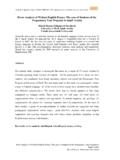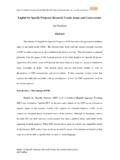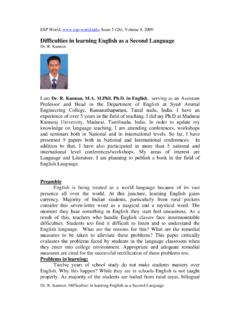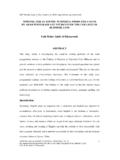Transcription of Technology in ESP Pedagogy
1 English for Specific Purposes World, ISSN 1682-3257, , Issue 48, , 2015 El bieta Danuta Lesiak-Bielawska. Technology in ESP Pedagogy 1 El bieta Danuta Lesiak-Bielawska Fryderyk Chopin University of Music Chair of Humanities Technology in ESP Pedagogy The article aims at giving a brief overview of the use of Technology in ESP Pedagogy . Its first part provides a historical perspective on computer-assisted language learning (CALL), its three distinct phases, and subsequent developments in information Technology (IT). The sections that follow focus on the use of Technology as tool for supporting traditional forms of language learning and for creating various contexts for communicating. The article closes with suggestions for further research into the use of Technology in ESP Pedagogy , its impact on the multiple roles of the ESP teacher mentioned in the literature of the subjects, and the resultant implications for specific training programmes for teaching practitioners.
2 Key words: ESP, CALL, Technology , ESP teacher, ESP teacher training 1. Introduction English for Specific Purposes (ESP) refers to the teaching and learning of English as a second/foreign language which, in contrast to other pedagogical approaches, bases the course contents and objectives on the specific needs of target learners. Thus it is frequently contended that ESP is an umbrella term which covers a range of diverse teaching contexts. They are broadly defined as English for Academic Purposes (EAP), English for Occupational English for Specific Purposes World, ISSN 1682-3257, , Issue 48, , 2015 El bieta Danuta Lesiak-Bielawska. Technology in ESP Pedagogy 2 Purposes (EOP) and English for Professional Purposes (EPP). Since in each area of ESP teaching, it is customary to distinguish between general and specific purposes, its main branches are further subdivided.
3 Accordingly, in EAP, it is possible to differentiate between English for General Academic Purposes (EGAP), English for academic reading, and English for Specific Academic Purposes (ESAP), English for medical studies (Basturkmen, 2010). According to Dudley-Evans & St. John (2009), the study of languages for specific purposes is centuries old. Its modern origins, however, go back to the early 1960s and are associated with J. M. Swales Episodes in ESP. During the early phase of ESP evolution, research focused on English for Science and Technology (EST) in academic settings (Hutchinson, Waters, 2010) and involved statistical grammatical counts within written discourse (Johns, 2013). By the 1980s, new technologies had found their application in ESP research, and investigations focused on analysis of large corpora.
4 Likewise, ESP Pedagogy has been significantly influenced by the use of Technology . Following the example set by Skinner (1958) and his teaching machines, computers have been implemented in language teaching since the 1960s. With the development of CD-ROM, more interactive activities and practice than paper-based materials were offered to language learners. The turn of the 20th century witnessed further changes in the shape of the foreign language classroom. Since then the Internet has had an enormous impact on the process of foreign language learning and teaching, and the development of a range of technological applications has offered tools for language learning and for creating a communicative space (Bloch, 2013). The objective of the present article is to give a brief overview of the use of Technology in ESP Pedagogy .
5 It consists of two main parts, Introduction briefly depicting the impact of new technologies on ESP Pedagogy , and a section with Conclusions. The first part of the article provides a historical perspective on computer-assisted language learning (CALL), its three distinct phases, and subsequent developments in information Technology . The sections that follow focus on the use of Technology as tool for supporting traditional forms of language learning and for creating various contexts for communicating. The article closes with suggestions for further research into the use of Technology in ESP Pedagogy , its impact on the multiple roles of the ESP teacher mentioned in the literature of the subjects, and the resultant implications for specific training programmes for teaching practitioners. English for Specific Purposes World, ISSN 1682-3257, , Issue 48, , 2015 El bieta Danuta Lesiak-Bielawska.
6 Technology in ESP Pedagogy 3 2. Technology in ESP Pedagogy Historical overview Technology has long played an important role in the teaching of ESP and its affordances have turned out to be extremely useful in ESP Pedagogy , given its clearly defined focus on needs assessment, materials creation/adaptation, ongoing course and/or materials evaluation, and methodology that draws on target situations and disciplines. As Technology entered ESP classrooms, teaching practitioners made use of interactive multimedia packages, Internet resources, and various tools designed to create specialized materials with a view to promoting learners engagement with relevant target situations (Arn -Mac a, 2012). It is contended that the relationship between information Technology (IT) and ESP remains under a strong influence of the evolution of computer-assisted language learning (CALL) alongside developments in applied linguistics and language teaching (Arn -Mac a, 2012).
7 As pointed out by Garrett (2009: 719), CALL, which refers to the full integration of Technology into language learning , should be based on the interrelation of such elements as Pedagogy , theory and Technology . Looking at its rapid development from the perspective of underlying theories and avalaible Technology , Warschauer (1996), Warschauer & Healey (1998) distinguish three distinct phases of CALL. In the behaviorist phase, conceived in the 1950s and implemented in the 1960s and 1970s, the computer was used as a vehicle for delivering instructional materials to students by means of different tutoring systems. The PLATO system, for instance, provided vocabulary drills, brief grammar explanations and drills, as well as translation tests. In keeping with the then-prevailing behaviorist theories of language learning, programmes like the PLATO system entailed repetitive language drills for the sake of practice.
8 The communicative phase of CALL, frequently distinguished from behaviorist CALL not by the kind of software used, but by the purpose to which a given computer programme is put (Warschauer, 1996), was based on the communicative approach to language teaching that predominated in the 1970s and 1980s. Its basic tenets emphasized the focus on using forms rather than the forms themselves, implicit grammar teaching, creating a natural environment for the target language use, etc. (for more details see Underwood, 1984). Accordingly, during English for Specific Purposes World, ISSN 1682-3257, , Issue 48, , 2015 El bieta Danuta Lesiak-Bielawska. Technology in ESP Pedagogy 4 that period several computer programmes were developed and used to provide skill practice in a non-drill format (which was an extension of the computer as a tutor model), to stimulate discussion or writing (the computer as a stimulus model used for communicative activities), and/or to empower learners to use or understand language (the computer as tool model) (Warschauer, 1996).
9 Reassessments of the communicative approach and the resultant more integrative teaching of various aspects of language dovetailed with advances of computer Technology . Integrative approaches to CALL were based on two important technological developments multimedia Technology allowing access to a wide variety of media (text, graphics, sound, animation and video) and the Internet, a medium of global communication and a source of innumerable authentic materials (Warschauer, 1996). Further developments in IT and language teaching have brought about such concepts as network-based language teaching (NBLT), which in contrast to CALL, traditionally associated with self-contained, programmed applications such as tutorials, drills, simulations, etc, involves human-to-human communication and collaboration (Kern & Warschauer, 2000), and a second wave of online learning, which expanding its focus beyond language learning, places emphasis on culture ( , intercultural competence, cultural learning, cultural literacy) and social discourses (Kern, Ware and Warschauer, 2004).
10 Observing mobile Technology moving at a dizzying pace, one cannot but agree with Arn -Mac a (2012) that the very concept of CALL needs to be extended to include the latest mobile devices. The Internet has given rise to significant changes in language learning. The acronym ALIVE standing for the concepts of authenticity, literacy, interaction, vitality, and empowerment best captures the nature of these developments (Warschauer, Shetzer, and Meloni, 2000). These concepts are of particular importance to ESP learners, who aspire to join target discourse communities. Owing to limitless Internet resources, they are provided with a wide range of authentic materials, as well as opportunities to actively interact with members of these communities through e-mails, forums, blogs, etc. The use of various Web applications can considerably contribute to learners empowerment, and help them gain control over their learning.









